A College Excellent & Nice
After fleeing Germany and hiding from Nazi occupation in Holland, sisters Gerda ’49 and Doris Bloch ’51 made their way to South Hadley to continue their interrupted education
The letter began simply. “I should like very much to apply for a scholarship at the university of South Hadley.”
The words may have elicited a smile from Mount Holyoke Academic Dean Harriett M. Allyn when she read the plain, handwritten note. Perhaps the origin of the April 1946 letter also piqued her curiosity, given that its return address was Kampen, Holland. Less than a year before, the Netherlands had been liberated from German occupation.
For certain, the story that unfolded in Gerda Bloch’s three pages won Allyn’s full attention. “Born in Berlin . . . emigrated to the Netherlands, against the German persecution . . . the Germans invaded . . . all Jews had to leave ordinary schools . . . we had to leave our parents . . .we lived in hiding . . . we never saw our parents again.”
Allyn recognized that, written between the lines of the two hundred-odd words, two orphaned young women wished to restart their lives in the United States. She would help make that possible, and Gerda and Doris Bloch did indeed make their way to Mount Holyoke, graduating with the classes of 1949 and 1951, respectively.
Their days at the “university of South Hadley” would be at the fulcrum of two lives that witnessed not only the painful losses of the Holocaust but the quiet good works of the adult lives that followed.
A Childhood Transformed
In an interview conducted in 1997, Doris Bloch remembered her early years. “I was just an ordinary kid growing up in an ordinary family.”
The Bloch sisters were the children of two architects, who operated an engineering firm out of their Berlin apartment. Richard Bloch, the girls’ father, had served in the Kaiser’s army in the Great War. “My father was an optimist,” Doris recalled with evident sadness.
His confidence in their comfortable lives vanished with Kristallnacht—the Night of Broken Glass in November 1938. Across Germany and Austria, thousands of men in the Nazi party paramilitary (the so-called “Brown Shirts,” though on that night most wore civilian clothes), together with boys in the Hitler youth, attacked Jews and their property in a night of wanton destruction. Some thirty thousand Jewish men were arrested in a matter of hours and sent to prisons and concentration camps.
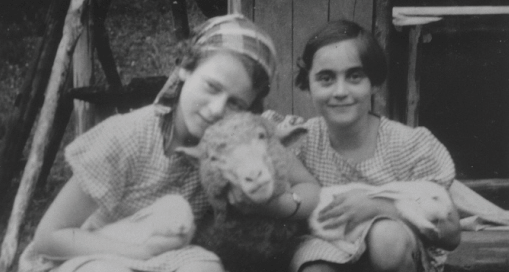
Gerda (left) and Doris on a farm in Germany in 1938. Photo courtesy United States Holocaust Memorial Museum, courtesy of Doris Bloch
For Doris, the public launching of the Nazi pogrom was both bewildering and personal. Her school—along with hundreds of synagogues and thousands of Jewish businesses—went up in flames during the night of terror. She was anticipating the gift of a watch on her tenth birthday, as Gerda had received one three years earlier. But Doris’s birthday fell less than a week after Kristallnacht. Her father had hidden Doris’s timepiece in their home before he had gone into hiding in order to escape arrest.
For a time, the reunited family would live as before, but when the authorities forced most Jewish businesses to shut their doors, Richard Bloch prepared to leave Germany. He secured tickets for Shanghai, but as their departure date approached, in March of 1939, Richard and his wife, Ilse, seized another opportunity, moving with their two daughters to the safety of the Netherlands.
The security of neutral Holland proved illusory, and the Germans invaded in May 1940. After the Nazi occupiers ordered the Jewish population from the coast, the Blochs relocated inland. But by the end of 1942, with many Jews already being deported to detention camps in Poland, a plan was made for the family to separate. Richard and Ilse took refuge together in a nearby town, while Doris and Gerda, aided by the Dutch underground and armed with new identity papers, bade their parents farewell.
“That day my sister and I got on the train just like we were going to go to school,” recalled Doris. “We . . . took off our Jewish stars, and that was that.” The sisters were separated. Gerda took the name Nancy. As Dorothea Blockland, Doris became the seventh daughter in a farming family in eastern Holland.
When Doris offered her testimony a half century later in a Shoah Foundation interview, the video camera captured a somber middle-aged woman, her hair in a salt-and-pepper page boy, her manner matter-of-fact, speaking with a just discernible trace of a German accent. But a deep vulnerability emerged when she spoke of the separation from her parents. Her voice breaking, eyes glistening, she recalled the parting: “I knew my parents could get killed. I knew I could get picked up.”
“I just kind of lived through it”
The Dutch families who hid the Blochs were kind. But the specter of capture meant the girls rarely left their houses in daylight. Separated by some sixty miles and a veil of silence, they heard nothing of one another or of their parents.
Helen and Carl Johann Derksens’ farm offered Doris hiding places, including a void in a wall behind an unobtrusive door in the rambling farmhouse and, high in a nearby barn, a horizontal space between quantities of hay. The family took in men hiding from the Germans, too, including a Canadian flier, emaciated from time spent in a prisoner-of-war camp. When an American airman was downed nearby in a raid, Doris remembered Carl Derksen saying, “Oh, sure, [we’ll] take him. They can only shoot me once.”
Though just sixteen, Doris recognized the weight of the knowledge she carried. “I thought that I wouldn’t be able to keep all the secrets if somebody tortured me,” she said in the 1997 interview. “And so I asked the family, somebody in the family, could they find me some poison, which they actually did. And I carried it with me all the time.” During nights spent hiding in the woods, with the sound of German shouts within earshot, Doris remembered feeling for the poison in her pocket.
During nights spent hiding in the woods, with the sound of German shouts within earshot, Doris remembered feeling for the poison in her pocket.
Doris and her protectors listened to British newscasts on the radio. She helped around the house and worked on her English, reading a great deal and talking with the American and Canadian visitors. Meanwhile Gerda worked quietly as a nanny, caring for the children of her protectors, Reverend Adriann Faber and his wife, Anna.
As for the fate of the Jews? “I knew,” Doris recalled. In the case of Dutch Jewry, fewer than one in four are thought to have survived, although among those hidden by the underground the survival rate is estimated closer to two-thirds. The sisters were luckier than their famous contemporary Anne Frank, but they understood Frank’s sentiments when she wrote in 1943, “I simply can’t imagine the world will ever be normal again for us. I do talk about ‘after the war,’ but it’s as if I were talking about a castle in the air, something that can never come true.”
Before the full story of the Holocaust reached the sisters, Allied successes permitted them a taste of freedom. On May 5, 1945, the German occupiers capitulated. “I enjoyed being outdoors and walking around, talking to everybody, the liberating forces,” Doris remembered. In a letter to Mount Holyoke’s Allyn, Gerda described it as “the happiest day in my life.”
But word of their parents’ transport to concentration camps, at Westerbork and Theresienstadt, and their deaths at Auschwitz in 1944 came soon after.
At Home in South Hadley
In response to the 1946 letter of inquiry, Allyn dispatched a Mount Holyoke catalogue to her new correspondent in Holland. The process of securing transcripts soon began, and, in the course of the year that followed, applications and other paperwork crossed and recrossed the Atlantic.
Though their formal education had been interrupted when they went into hiding, the reunited sisters had resumed their schoolwork in September 1945 in Holland. Gerda took her secondary school examinations in May 1946, and, with a plan to emigrate to the United States taking shape, she enrolled at the Institute for Social Work in Amsterdam. She took a typing class. “We have heard that your colleges are excellent and nice,” the Bloch sisters wrote to Allyn again in January 1947 as they awaited word of admission to Mount Holyoke. “It is very good to have various educations.”
At Mount Holyoke the Bloch sisters also had a sponsor in Henry Rox. A woodcarver and sculptor, Rox, along with his wife, Lotte, had been part of the Bloch’s circle of artistic friends in Berlin before escaping to England in the early nineteen-thirties. In 1938 Henry Rox became an assistant professor at Mount Holyoke, teaching studio classes and courses in art history.
The sisters sought—and eventually received—financial support from the Institute of International Education. Gerda came to the United States in mid-1947, Doris two years later. Once on campus Gerda tutored students in German under the auspices of the College’s department of German. She studied psychology and philosophy but expressed a continuing interest in social work.
Doris would major in zoology. “I had always wanted to be a doctor or a nurse,” she recalled. “When I was a little kid, I used to drill little holes in my doll’s arm—that was the injection. I remember from Germany, so that’s way back. I opted for nursing. I was thinking that all along.”
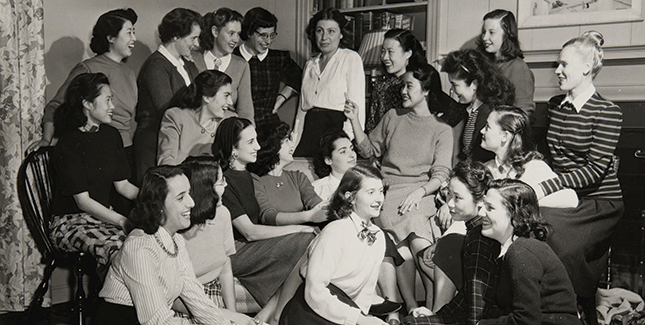
A 1948 photograph of a group of Mount Holyoke international students includes Gerda Bloch ’49 (standing second from left).
Mother of Nursing Research
When asked to state their nationality, the young women entered “stateless” on their application forms. But their Mount Holyoke years proved to be a prologue to new lives in America.
On leaving South Hadley, Gerda headed for the Columbia University School of Social Work, where she earned a master’s degree. Later she married, had two children, and worked for many years as a county social worker in northern California. After her retirement at age sixty-five she worked as a psychotherapist with children with developmental disabilities. At age eighty-three she retired a second time and today lives quietly in the skilled nursing wing of a retirement facility in Los Gatos.
Her sister’s career gained her national status in her profession. Heading directly to Yale after earning her undergraduate degree, Doris earned a master’s of nursing and became a registered nurse in 1954. She worked as an emergency room nurse in a New Haven, Connecticut, community hospital before joining the Visiting Nurse Association, first in Connecticut, then in northern California. With the turn of the decade, she traveled to Africa. “I learned some Swahili working in a Rwandan refugee camp,” she later said. But her time in Tanganyika (today’s Tanzania) “was not easy. Tough going.” Still, the experience put her on a path to public health.
On her return to the United States, she worked as a nursing supervisor while earning a second master’s in 1965 and then a doctorate in 1970, both in public health at the University of California, Berkeley. After working for the World Health Organization in the Philippines, she took a job in the Division of Nursing of the US Department of Health, Education, and Welfare, in Bethesda, Maryland.
Late in life, both Doris Bloch and Gerda Bloch Mosse would return to Holland to honor the families that had kept them safe from the Germans.
Doris would work for the federal government for almost a quarter century; by the time she retired in 1994, hers was an important and widely recognized legacy.
She helped found the National Institute of Nursing Research (NINR). With its establishment in 1985, nurse researchers gained a new status and, as co-author of the National Nursing Research Agenda, Doris helped establish research as a nursing priority. Her work initiated a shift in the medical mindset: the nurse researcher—rather than focusing on the function, disease, or treatment (as medical researchers do)—would partner with medical researchers. Doris made a persuasive case for looking at the patients and families as they dealt with disease. Much of nursing research would be clinical and patient-centered; by establishing nursing research and training programs, Doris argued, advances could be made in clinical practice, disease prevention, disability, and the management of symptoms caused by illness. She foresaw improved palliative and end-of-life care as well as a growing role for nurses in critical care and other medical skills traditionally restricted to physicians.
The profession today reflects her broader vision. According to Ada Sue Hinshaw, who served as the first director of the NINR from 1987 to 1994, Doris was more than merely present at the NINR’s creation. “She was practically the mother of nursing research,” Hinshaw said.
At the time of her death from heart failure in 2003, Doris was remembered warmly by former colleagues as a quiet presence in the profession. “There are the show people, then there are the behind-the-scenes people,” remarked Deidre Blank, another former chief of the NINR. “She just did her job.”
Doris also played a central role in shaping the formal structure for the NINR. She traveled widely as a grant administrator, reviewed journal articles, mentored many young researchers, and helped launch a variety of initiatives aimed at establishing nursing as a clinical profession. The recipient of several honors during her lifetime, including one from Yale’s School of Nursing and the Chairperson’s Award for Meritorious Service from the Council of Nurse Researchers, her memory was honored by nursing’s honor society, Sigma Theta Tau International, which established the annual Doris Bloch Research Award. She also funded a scholarship award at Mount Holyoke in honor of her parents.
Late in life, both Doris Bloch and Gerda Bloch Mosse would return to Holland to honor the families that had kept them safe from the Germans, succeeding in getting the Derksens and the Fabers entered on the rolls of Yad Vashen, Israel’s Holocaust Martyrs’ and Heroes’ Remembrance Authority. Yet some of Doris’s coworkers remained unaware of her Holocaust experience, learning of it only after her death. She devoted herself to her work and never married, but her discipline and commitment to her profession are warmly remembered by surviving colleagues. As one of them, Dr. Thomas P. Phillips, recently observed, “She was perhaps the best role model anyone could have when it comes to living one’s life with honor and courage.”
—By Hugh Howard
Historian and writer Hugh Howard is the author of numerous books, including Houses of Civil War America (Little, Brown, 2014).
A similar article appeared in the fall 2015 issue of the Alumnae Quarterly.
October 14, 2015


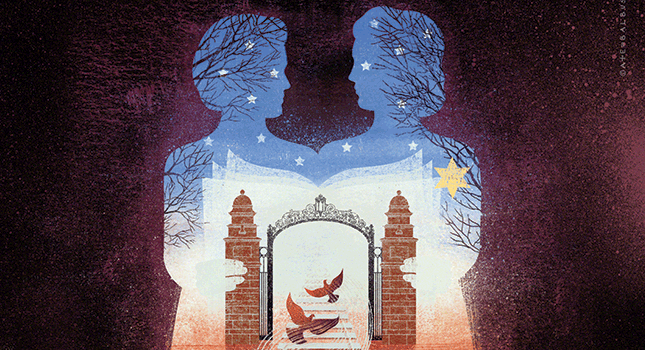





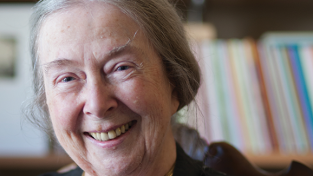

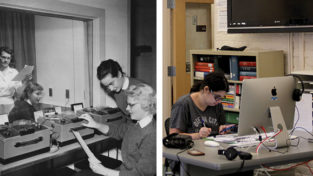
What a wonderful tribute to Doris and her sister! Thank you Hugh and Mt. Holyoke.
The article about Gerda and Doris Bloch was lovely and brought back many memories, as Gerda was a classmate. She had told us about some of her war experiences from time to time, helping us to piece together the unbelievable, traumatic events they had lived through. I think there was another girl from Holland, who was a year or so older, and who was also at Mt. Holyoke during some of the years that we were. She was a cousin, or someone distantly related but called a cousin. If I remember correctly, her name was Anneliese Hollander, and she may have been somehow associated with the class of ’48 I think she also received a degree in social work and ended up in California, too. Mr. and Mrs. Rox were the “mainstays” of the girls at college.
Thank you, this is a lovely article, and it is inspiring to learn about how these brave women started a new life at the gates of Mt. Holyoke.